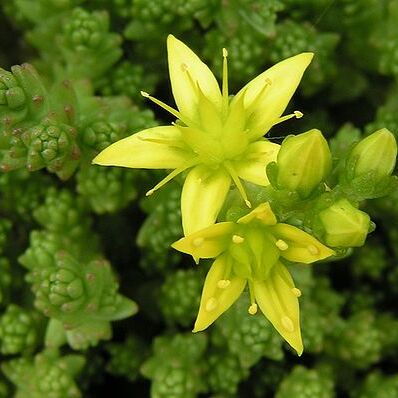Herbs annual or perennial, mostly glabrous, less often hairy. Roots normally fibrous. Rootstock usually not developed, occasionally plants rhizomatous. Stems erect or decumbent, sometimes fasciculate or mosslike, fleshy, glabrous or hairy, base rarely woody. Leaves alternate, opposite, or verticillate, base often spurred, margin normally entire (4-8-dentate in Sedum rosthornianum and remotely dentate in S. engleri var. dentatum). Inflorescence terminal or axillary, cymose, often corymbiform, 1-to many flowered. Flowers usually bisexual, rarely unisexual, mostly unequally (3-)5(-9)-merous. Sepals and petals free or basally connate. Petals free or almost so, mostly yellow, less often white or reddish. Stamens usually 2 × as many as petals, in 2 series, rarely equal in number to petals and in 1 series; antepetalous ones adnate to petal base or slightly above. Nectar scales entire or apex emarginate. Carpels usually as many as petals, occasionally fewer, free or basally widened and connate. Styles short or long. Follicles many or few seeded. Seeds smooth or papillate, less often striate.
Annual or perennial, erect, ascending or prostrate, sometimes caespitose or muscoid, fleshy herbs, rarely undershrubs, glabrous or glandular pubescent. Leaves very variable, alternate, opposite or verticillate, entire or serrate, rarely laciniate, flat or subterete, often spurred at the back of the base. Flowers usually in terminal cymes, rarely spicate or solitary in leaf-axils, ☿ or by abortion unisexual. Sepals 4-5, free or almost so. Petals as many, rarely 6-7, free, yellow, white or purple. Stamens as many as petals or usually twice their number, perigynous; epipetalous ones often adnate at the base to the base of the petals. Filaments filiform or subulate; anthers short, 2-lobed. Hypogynous scales entire or emarginate. Carpels 4-5, free or connate at the base, each narrowed into a longer or shorter style. Styles stigmatose on the inner side of the apex. Ovules usually several, rarely solitary or few. Follicles 4-5, free, erect or spreading, 1-∞-seeded.
Annual or perennial herbs, sometimes subshrubs, often forming mats. Lvs usually alternate, rarely opposite or verticillate, simple, entire or toothed, usually spaced along stem, sometimes crowded in terminal rosettes, occasionally scale-like. Infl. a terminal or axillary, corymbose, helicoid or secund cyme (often several cymes terminating a main inflorescence stem), sometimes paniculate, usually many-flowered. Fls 4-5-(9)-merous, erect to horizontal. Sepals free or almost so, equal or unequal. Petals free or slightly connate at base, erect or patent with corolla often star-like, white, yellow, greenish, pink to purple, very rarely blue, thin and scarcely succulent. Stamens usually twice as many as petals and in 2 equal whorls, occasionally as many as petals and in 1 whorl, free or occasionally epipetalous, exserted. Scales free, very variable in shape and size. Carpels free or almost so, usually 4-5. Seeds usually numerous, sometimes 1-few.
Annuals, monocarpic biennials arising from a basal rosette or perennials, erect or trailing. Leaves alternate or opposite, sometimes crowded, especially on sterile shoots, flat to terete, usually fleshy, often spurred. Inflorescence a few–many-flowered terminal cyme, corymb, panicle or raceme. Flowers (4–)5–(9–)-merous. Petals free or slightly joined at the base. Stamens epipetalous, twice as many as the petals or equal in number. Scale-like nectaries present between the stamens and carpels, small, entire, emarginate or dentate. Carpels as many as the petals, usually free or slightly united at the base. Seeds minute, 1-many.
Fls mostly 4–5(–9)-merous; pet distinct or united only at the very base; stamens usually twice as many as the pet, the antepetalous ones usually adnate at base to the pet; carpels distinct or nearly so, tapering to the short, stout subulate style; fr follicular; seeds numerous; succulent herbs or half-shrubs with thick or terete, alternate, opposite, or whorled lvs and small to middle-sized, yellow or white to anthocyanic fls. In addition to the following native and intr. spp., a number of spp. are cultivated and may escape locally. 300, mainly N. Temp.

